
Press C. Dowler was the architect of the school, and may have designed the urns as well.

Press C. Dowler was the architect of the school, and may have designed the urns as well.

William Arthur Thomas designed this First-World-War-era duplex,1 which is typical of the better class of Pittsburgh duplexes: it offers two spacious apartments (plus attic and basement), each with more square footage than many city houses. Thomas was very fond of white Kittanning brick, to judge by the number of his buildings that made use of it.



A while ago we mentioned that this building on Broadway in Beechview was undergoing a long-delayed restoration. Now, as the few Red Line riders who look up from their phone screens may have noticed, an addition is going up next to it, bringing an honest-to-goodness construction crane into Beechview for the first time in decades.



Gladys Avenue was one of the richest streets in the middle-class neighborhood of Beechview. We’ve already seen a bungalow designed by the notable Pittsburgh architect W. Ward Williams. Here are a few more houses nearby, beginning with another designed by Williams, this one a generously sized Tudor—or English-style, as it would have been called in 1914, when it was built.


They’re nearly obscured by shrubbery, but note the very interesting sloped porch supports of this house that echo the curving slope of the roof.

A generously extra-large foursquare. Have you noticed that these first three houses all have unusual diamond panes in the upper sashes of some of their windows? Those were also a feature of the bungalow designed by W. Ward Williams on the same street, making us wonder whether Williams was responsible for all these houses.



Father Pitt had a nice conversation with the owner of this house, who tells us that it was built in about 1919. If you peer into the shadows behind the flag in the picture above, you may notice an exceptionally fine art-glass window in the parlor.



Looking down a steep slope on Fallowfield Avenue in Beechview. Bricks were used to pave relatively flat sections of streets in hilly neighborhoods, because bricks were cheap and durable. But bricks are slippery when wet or icy. More expensive Belgian block, which gives better traction, was used for slopes.

Casimir Pellegrini Associates were the architects of this church, whose cornerstone was laid in 1963. It was a Franciscan parish until just a few years ago. Unlike some other abandoned Catholic churches, this one has a happy ending: it was bought by the thriving Lebanese Maronite Catholic congregation of Our Lady of Victory, which began in Brookline (or arguably earlier in the Lower Hill) and spent years banished to the wilds of Scott Township. In honor of Pittsburgh’s best Lebanese festival, which begins today and lasts all weekend, here are quite a few pictures of St. Pamphilus/Our Lady of Victory, which old Pa Pitt has done his best to make look like period-appropriate Kennedy-era Kodachrome slides.

The Our Lady of Victory congregation has graciously allowed St. Pamphilus to stay in his home on the front wall of the church, where he distributes bread to begging hands.



Father Pitt will admit that he does not find the nave the most attractive of all our church buildings. It is dignified and spacious, and that is enough. But the tower, a mailbox on stilts, captures his imagination, and he would hate to see anything happen to it.







The church was dedicated to St. Pamphilus, but it is St. Francis who greets you at the door with his usual motto “Pax et bonum.”


This shrine to Our Lady of Victory is now in its third location.

Father Pitt makes it a practice to try to record all the names on a war memorial, because sometimes things happen to inscriptions. If you enlarge this picture, every name should be clearly legible.

A plaque remembers Msgr. Elias P. Basil, the founding pastor of Our Lady of Victory parish. He had been pastor of St. Anne’s, the Maronite church in the Lower Hill. The story is that he promised St. Mary that, if all his parishioners came home safe from the Second World War, he would build a church in her honor. They did, and he did.

St. Anne Church was on Fulton, later Fullerton, Street, one of the Lower Hill streets that no longer exist because they were urban-renewaled to death. This cornerstone was preserved from the demolished church.





Shadycrest Village was just beginning construction when it opened for inspection on Valentine’s Day of 1943. The first stage of the development included modest six-room houses like these, done in the cheap and simple 1940s interpretation of the “Colonial” style.
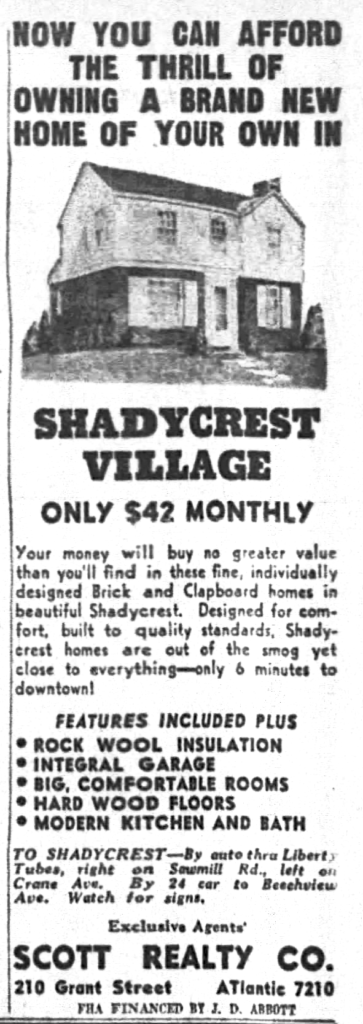

Economical though they were, the houses were up to date, according to the puffery the developers distributed to the papers.
Noteworthy features being built in Shadycrest homes include colonial balustrade stairways, which are wide and easy to climb; improved bathroom fixtures; medicine cabinets, linoleum kitchen and bathroom floors; improved steel casement windows, easy to clean from inside the house, insulted ceilings, Kastone laundry trays, tilt-up garage doors, cabinet sink sets, wallcases edged with non-corrosive metal, and electric ventilating fans.
They also had generous lots to stand on, and—since we were in the middle of the Second World War—the publicity pointed out how much space you would have for a victory garden.
Lots in this development will all be good-sized, ranging from 100 to 200 feet deep. This means that owners will have enough ground for their own victory gardens and can raise their own vegetables.

The location was a big attraction—“so near the downtown district, and above the smog level”—although “6 minutes to downtown” assumes no pauses in driving through the Tubes, which was no more likely in 1943 than it is now.

The development continued to grow, and the larger part of it was made up of five-room double houses in the same simplified Colonial style. These sold rapidly at the end of the war, as returning soldiers looked for places to settle down and raise families.

Cheap though they were, these little houses have aged well. The neighborhood is still very pleasant today, and we notice that many residents still take advantage of the generous lots that come even with the doubles to plant cheerful gardens.

If you visit a friend in Shadycrest, you may need to be very careful about your navigation. The development began on established streets like Tropical Avenue, but as it grew the developers added new winding dead-end streets, and they had to come up with names for them. So…
Shadycrest Drive
Shadycrest Road
Shadycrest Court
Shadycrest Place
Shadygrove Avenue
Shadyview Place
Finding a house in Shadycrest requires an instinct for pedantic specificity.




W. Ward Williams was the architect of this bungalow, which was built in about 1911 for Ward Brown1 and has been preserved in excellent condition. It was the subject of a photo feature in the Gazette Times for October 12, 1913.
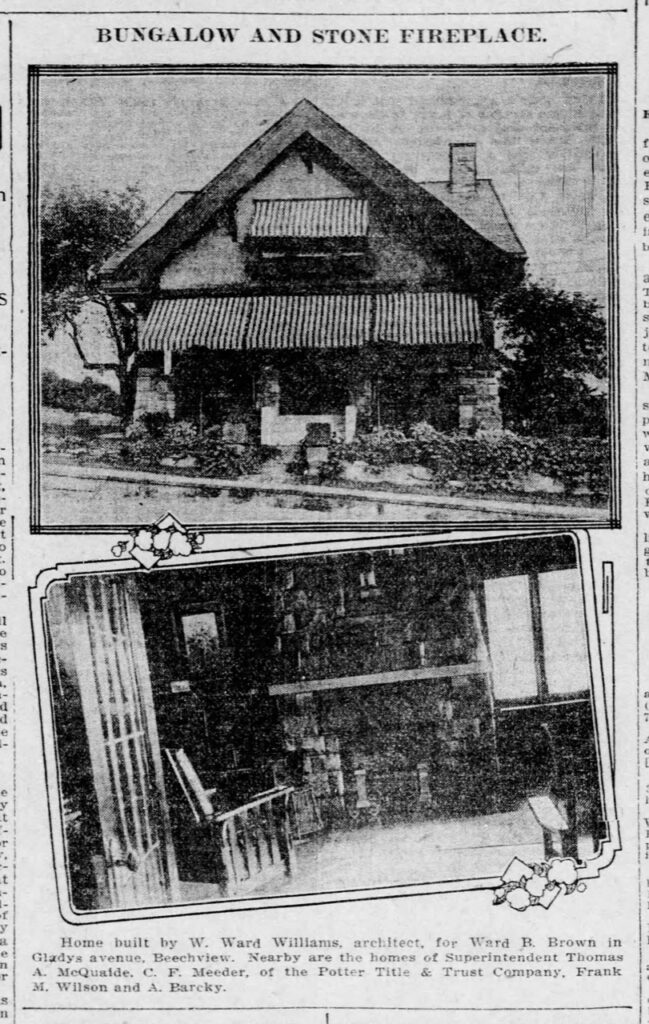

A garage that looks like it wants to be just like Daddy when it grows up.




T. Ed. (for Thomas Edward) Cornelius was the architect of this little Arts-and-Crafts Gothic church.1 Cornelius was a lifelong resident of Coraopolis, but he flourished for decades as a designer of small to medium-sized projects all over the Pittsburgh area. This building has not been a church for quite a while, but its current owners keep it up neatly, though they have adapted it to radically different uses.



About twenty years ago, there was an aborted attempt to revitalize the business district of Beechview—aborted because the developer absconded with the money and went back to his native Brazil, whence, according to the Brazilian constitution, he could not be extradited. So neighborhood gossip tells us, at any rate. The project had got as far as partly restoring this building, and a thriving restaurant occupied the ground floor for a while. But then the furnace broke, and the landlord was gone, and the building was tied up in legal wrangling and became uninhabitable. Meanwhile, much of the business district more or less revitalized itself, with a big Mexican supermarket and a number of interesting ethnic restaurants moving in.
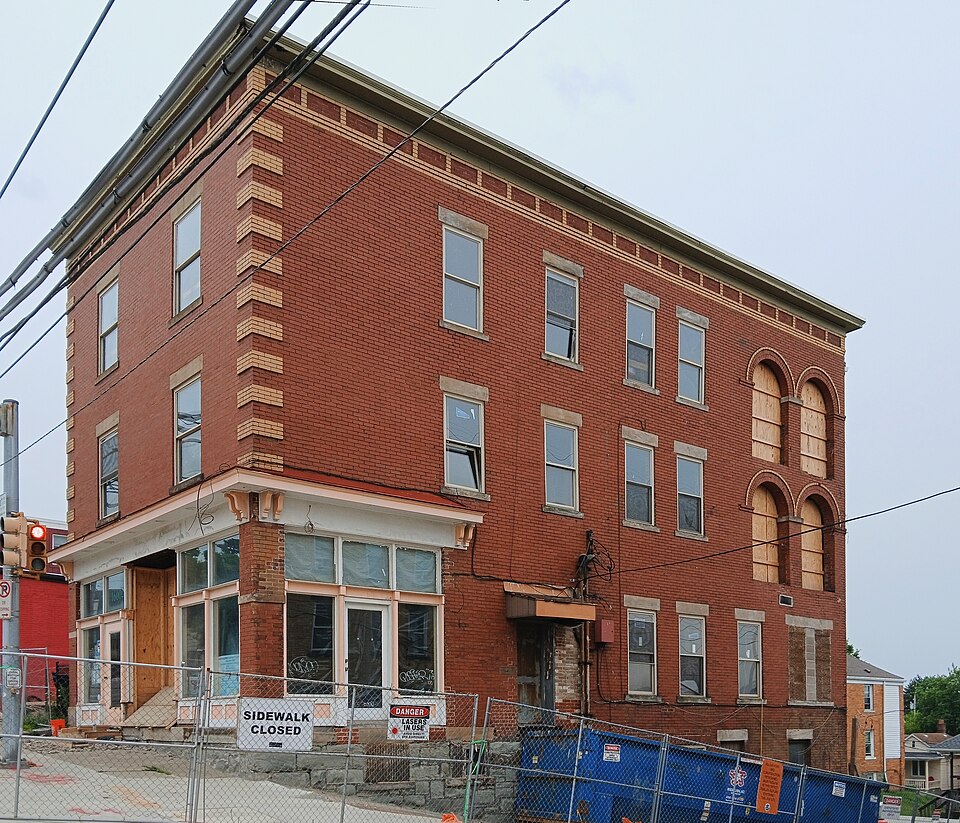
Now, at last, the restoration is beginning again, and this time it seems very thorough. It’s an attractive building that deserves a long future. Old Pa Pitt hopes his readers will pardon these hasty cell-phone pictures, taken as he happened to be passing by without his usual big bag of cameras.
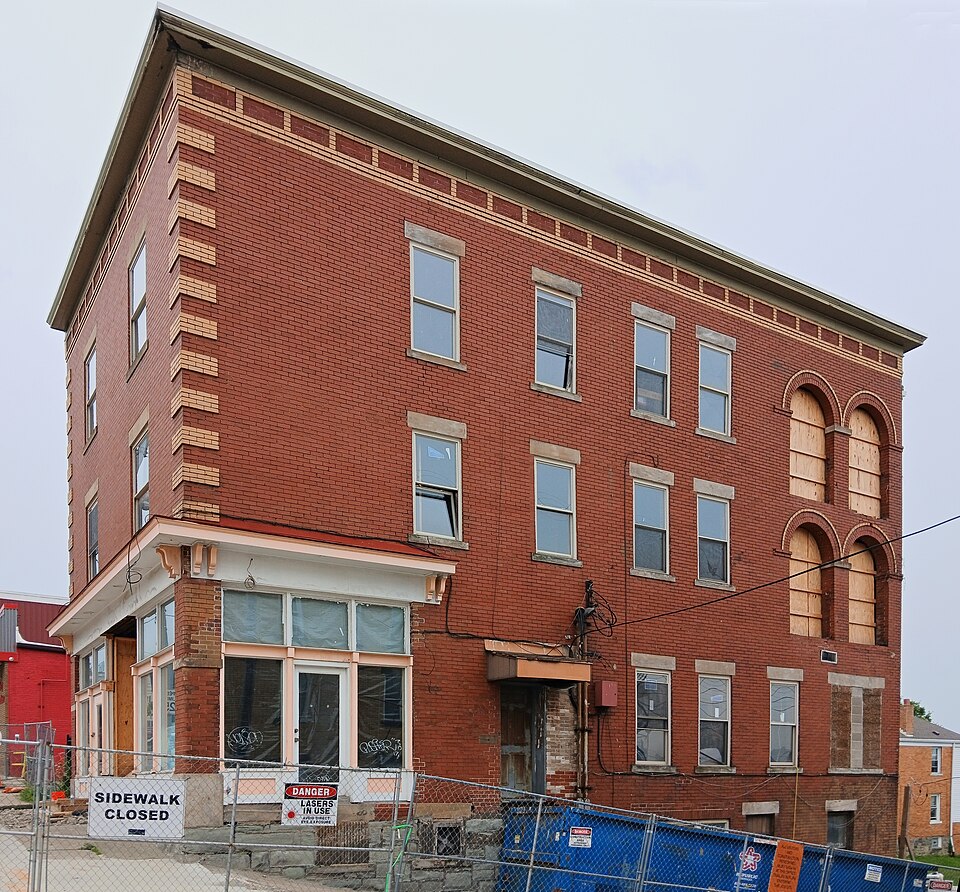
Although Father Pitt has no evidence other than the style and the location, he suspects the building was designed and built by local architect and contractor William J. Gray, who was responsible for the Boylan Building on the opposite corner of the same intersection and for a now-vanished building on one of the other corners—and quite possibly for the building on the fourth corner as well.
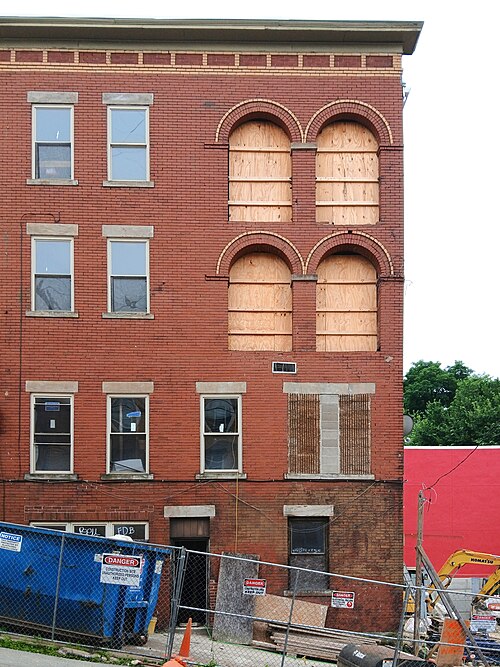
These arches framed inset balconies for the upstairs apartments. It looks as though they are to be filled in, which may be necessary to make the building rentable, but will take away a distinctive feature.
